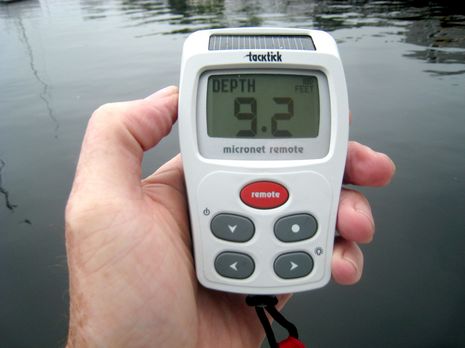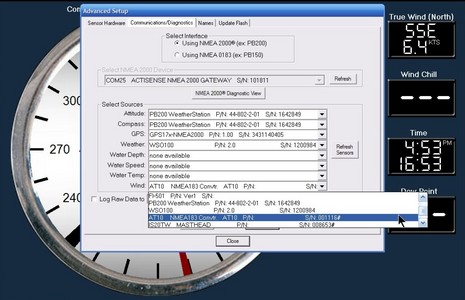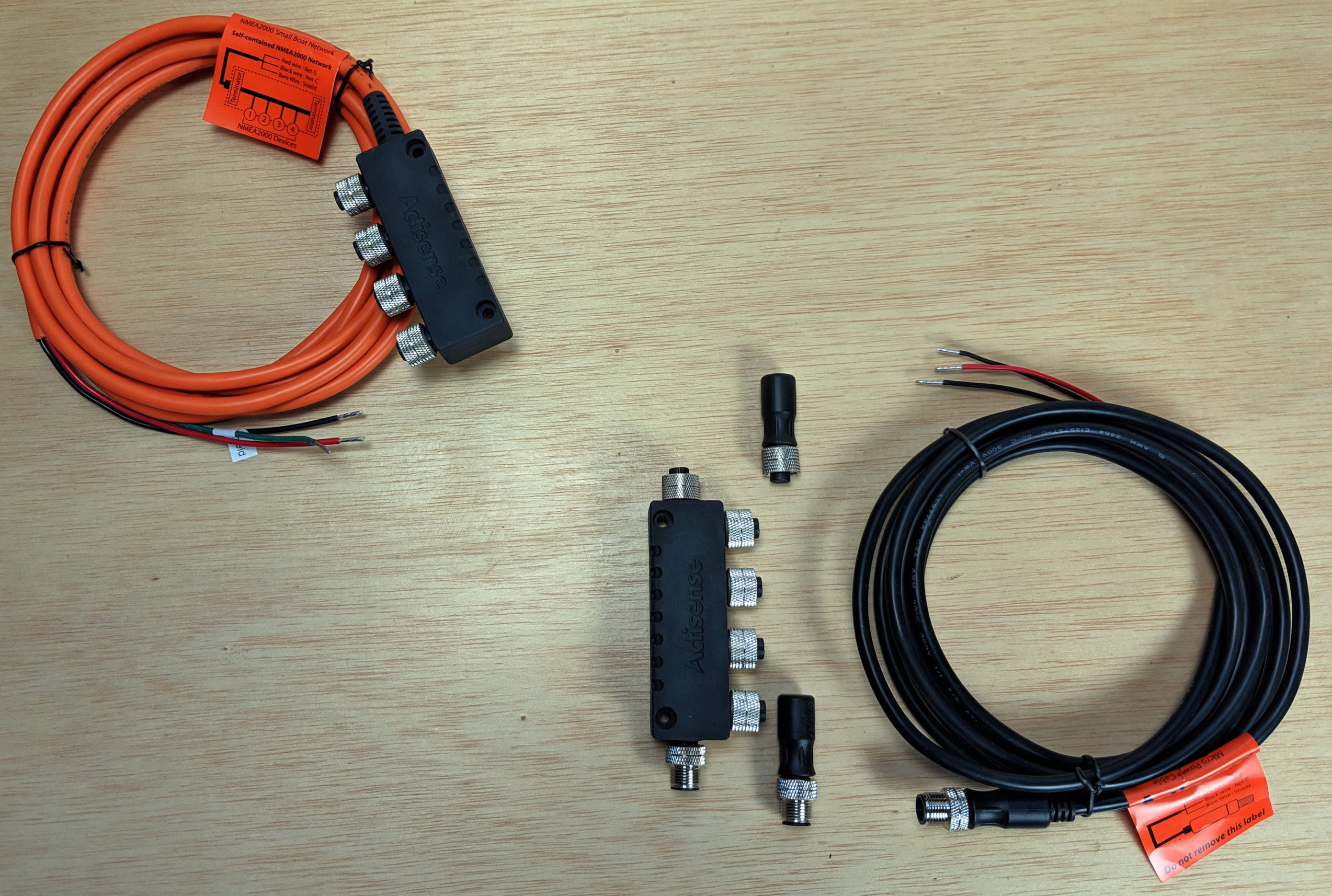Wireless N2K wind & more, Tacktick style
Mission accomplished! I tried integrating a Tacktick wireless sensor and display network with a NMEA 2000 sensor and display network, and the results were quite good. The depth seen on the remote above is coming from a Maretron DST100 in Gizmo’s bottom. The Micronet system is also getting Heading, Speed through Water, COG/SOG, and more from the N2K system, which it can display and/or use for True Wind calculations. Meanwhile — and perhaps coolest of all — all displays on the N2K backbone are getting Apparent Wind info from the wireless Tacktick wind vane I simply clamped to Gizmo’s mast…
Installing a regular N2K wind sensor can be problematical. The cables and/or made-up connectors tend to be bulky, with the notable exception of the SimNet whirly, and unless your masthead is less than 20 feet from the boat’s N2K backbone, that backbone has to terminate at the masthead, which involves an inline or built-in resistor. Just fastening a solar-powered Tacktick T120 or T123 up there is relatively painless. Integration with N2K wasn’t hard either, and is going to get easier. I just wired Tacktick’s otherwise wireless, and quite able, NMEA 0183 interface box to a Simrad AT10 0183/2000 translator which then went to the backbone via a SimNet-to-DeviceNet (male) patch cable. The “almost done” Actisense NGW-1 will mean no patch cable (and purportedly a more complete data translation matrix). And, get this, Tacktick is working on a Micronet-to-NMEA 2000 interface box.
And that’s not all I learned from Tacktick MD Clive Johnson over the phone recently. He sounded quite excited about the future of Tacktick now that it’s been acquired by Suunto, including wider distribution here in the States (there’s already a new U.S. online sales site). He also confirmed some details I’ve been gathering about the economy wind system Tacktick introduced last winter. The new MN 30 non-solar wind display does not do all that the standard displays do — like no close hauled or VMG screens — but it does have the same extensive wind sensor calibration abilities. And, remember, that’s particularly important if you want to integrate the wind sensor into a NMEA 2000 network. All sorts of N2K displays can do all sorts of things with Tacktick wind info, but only a Tacktick display can calibrate the wind vane (including the nifty T106 remote, incidentally).
Finally, check out the screen shot below. That’s Airmar’s latest version of WeatherCaster talking directly to Gizmo’s NMEA 2000 network. I could not only choose the Tacktick vane (aka AT10) as a wind source, but could also calibrate the PB200 every which way. And note that this screen was taken just before I realized that the Maretron DST100 triducer (probably made by Airmar) fits fine in the same thru hull sleeve which once housed the Horizon speed/temp sensor (probably made by Airmar) that was installed on Gizmo in 2000. I could kick myself for not trying that wet experiment sooner. Some electronics are more compatible than we may realize.















Ben,
I know this is not a “commercial site” but you discuss gear and rarely if ever mention the cost of the gear you write about – not even the mfg retail price. Of course much of these neat devices require installs as well and we can only guess at what those costs may be.
Do you think you could give us some broad concepts about the costs of these devices?
For example, the Iphone has hundreds of apps… but what are the costs of these “add ons? It becomes a more complex decision when one tries to add it all together.
Great review, Ben. But a couple of things Tacktick does not make clear in their ads or manuals are: 1) Does the NMEA interface have a wireless receiver? I assume so, or it couldn’t transmit wind info via the NMEA out port, as you demonstrated, but nowhere that I’ve seen do they explicitly say it receives wireless signals. 2.) One would assume an NMEA-0183 capable speed/depth transducer could be connected directly to the NMEA interface box, eliminating the need for a “wireless hull transmiter”, but again, they don’t mention this explicitly in any website material I’ve seen. Nit Picking? Perhaps, but both issues make a substantial difference to an already pricey Tacktick installation.
John, the box’s full name is NMEA Wireless Interface and it is certainly sending and receiving data wirelessly. Tacktick’s NMEA page illustrates many set ups:
http://www.tacktick.com/page.nmea
There’s also a brief manual under Support/User Guides.
I’m quite sure that an Airmar NMEA 0183 Smart depth/speed/temp transducer could be wired directly to Tacktick’s Wireless Interface. After all, that’s pretty much what’s happening in the top photo. Standard 0183 depth data from the AT10 is coming via wire into one the Wireless Interface’s 0183 In ports and being transmitted to the Remote.
I’m not sure if you could apply a keel offset in the Tacktick system, though, or do any other calibrations on the Smart sensor.
Ben … Tick tack has a race master product that makes use of external wind and an internal heading sensor and GPS to go beyond just reporting true wind, it reports lifts and headers that are used to make decisions if a sailboat should tack or jibe.
Althought it would appear clear that this nmea interface could take the heading, speed over water, and PB200 ultrasonic apparent wind angle and speed and put it on the tack tick network … would the race master use it to override it’s internal devices to take advantage of external solid state compasses, ultrasonic speed thru water, and ultrasonic wind ?
Tack Tick’s Wireless 0183 interface box Recieves everything on the Micronet wirelessly the same as all of their displays. It has 2 0183 inputs which allow you to input your other NMEA information to be transmitted out wirelessly to the Micronet such as Ben has done here with the wireless controler and 1 output which allows you to take all of the information running through the Micronet and feed it to your NMEA 0183 system or in this case convert it to 2000 and put it into you backbone. You can not wire their transducers directly to the interface box, but something neat that most people don’t know about is you can wire almost all airmar instrument transducer to their hull transmitter it is a bare wire connection. Not sure if the 0183 smart sensors will connect directly to the wireless interface box though.
John
I am thinking about installing a Tack Tick system on my Swan 46 replacing my old B&G. I am looking product test and consumer reports.
Nice idea, but the data is still flowing at 4800b or the tacktick wireless interface limit, is there any way to get it up to full N2K speeds?
Rumors persist that Tacktick is working on a NMEA 2000 interface, which I think would be a nifty install simplification if the added cost isn’t massive. But data speed and sensor refresh rate are two different things. If Tacktick’s refresh rates aren’t pushing the boundaries of NMEA 0183 now, increasing the bandwidth shouldn’t make a difference.
I recently asked the Tacktick technical staff if one could connect an Airmar 0183 smart speed transducer directly to the T122 wireless interface, skipping the installation of a hull transmitter, and if so, could it be calibrated in the normal manner with a Tacktick display. They replied:
“This is an option with calibration correcting the NMEA value at the displays for the system.
We do not tend to market this option as the T122 for our system is very much the wireless converter to NMEA and vice versa. Also the volts/amps requirements start to push the boundaries of the whole solar/battery concept not to mention wiring involved over the standard Hull set up.
So long as the 2 T122 inputs are sufficient for the customer’s set up all should be o.k.”
So the answer to both of my questions is a cautious yes, although it sounds as though it would be best NOT to power the transducer from the wireless interface. I had previously asked about wiring a smart depth transducer to the wireless interface and received similar answers.